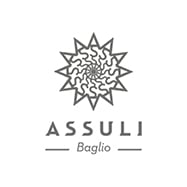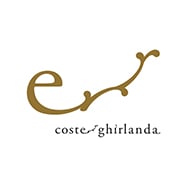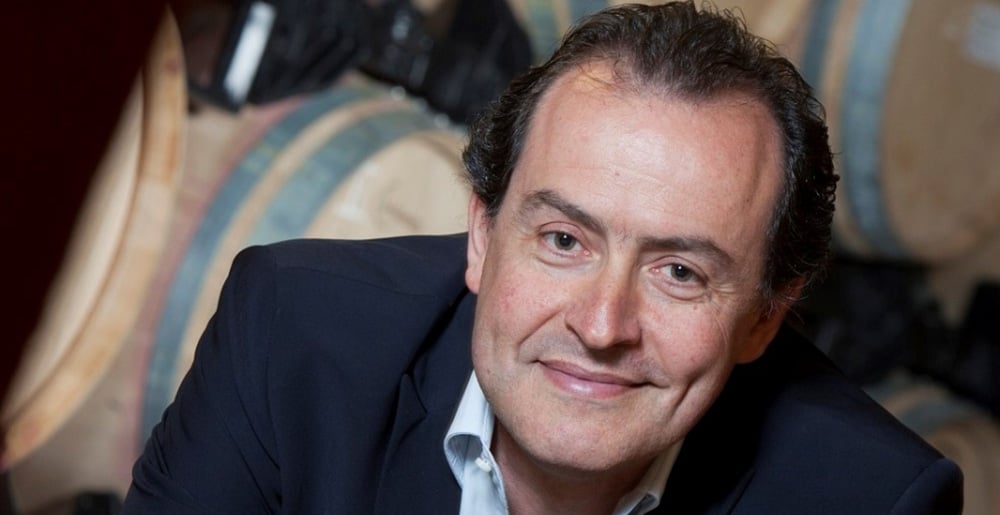Lorenzo Landi, born in 1964, grew up in the town of Pescia, near Montecatini in the province of Pistoia, a spot not known for its viticulture but rather – even if it borders on Montecarlo di Lucca, a township which is also a controlled appellation – for its plant nurseries, flower cultivation, and, in springtime, its “giant asparagus”. His family was not involved in wine or in viticulture in any way, but his father, fortunately, had a passion for fine wine, something Landi obviously inherited.
The young Landi, nonetheless, decided to enroll in the local agricultural high school and then in the agronomy faculty of the University of Pisa. At that time, the 1980’s, oenology was not taught at the university level in Italy; the subject, instead, was taught in a single course together with the production of olive oil and cheese and the raising of animals for the production of meat. A Masters Degree in oenology, therefore, was the next step, and was received from the Catholic University of Piacenza in Italy’s northwest. The theoretical training was then followed by an apprenticeship in Puligny-Montracht, at nothing less than the Leflaive winery, then as now one of the great names for the production of white wine in Burgundy. Once back in Italy, Landi accepted, in 1991, as his first professional job, the technical direction of an important Tuscan cooperative winery, again in the province of Pistoia, in the township of Vinci, one which had taken the name of the immortal Leonardo da Vinci. And, up until the year 1996, he supervised the production of large quantities of wine. In that year, he moved to Montepulciano to become the technical director of the Fattoria del Cerro, at the time and even today the largest private cellar in the famed Vino Nobile di Montepulciano DOCG. The property was part of the landed holdings of the SAI insurance company, and precisely in that period a program of expansion began which led to the establishment of two other important estates, Poderina at Montalcino and Col Petrone in Umbria’s Montefalco DOC. Their excellent wines, together with those from Montepulciano, were made by Landi for over 15 years. The decision to become a consulting professional was taken at the beginning of the new millennium, and from that moment on Landi’s career has taken him, regularly with great success, all over Italy, from Friuli in the northeast all the way to the southernmost part of the Italian peninsula. And Sicily obviously has been part of this oenological Grand Tour.
Q. Tell us about the beginning of your working relationship with Sicily and what you found when you first arrived
 A. It all began in 2003 – shortly after I had decided to become a consultant – with the Cottanera winery in the township of Castiglione della Sicilia on Mount Etna, property of the Cambria family, entrepreneurs in the nearby city of Messina. I don’t really know why they contacted me, perhaps through the good offices of the agent who handled the American market for them, a dynamic and capable man from the Trentino area of northern Italy with whom various of my wineries were working with much pleasure and profit. The estate, which now cultivates over 160 acres of vineyard, was smaller at the time, if not by much, and shortly after my arrival concluded an important purchase, a parcel of old-vine vineyards in the Calderara sub-zone of the Etna DOC, the spot which supplies the grapes for the top wine of the house, the Etna Rosso Riserva Zottorinotto. In addition to the age of the vines, there was the added importance of the zone, in my opinion one of Etna’s finest and endowed with the classic volcanic soil of the mountain. A substantial part of the vineyard surface, however, had been planted during the 1990’s and, given the ideas which prevailed at that time, not only in Sicily but virtually everywhere in Italy, it is no surprise that various parcels were also planted with the classic international grape varieties, the usual Cabernet, Merlot, and Syrah along with Mondeuse, a grape from the Savoy region of eastern France which there, in an area which is high in altitude and cool in climate, gives, to be generous, wines of only medium level. But on Etna, instead, with a climate which is obviously much warmer and much sunnier, we have succeeded in producing wines with another type of body and structure, certainly of an unexpected level. International-style wines, however, have become notably less requested during the last ten years and nothing could be more natural and logical than the desire, stronger with every passing year, to drink wine with those special characteristics which only native grape varieties, cultivated, fermented, and aged properly in their home territories, can offer. Accordingly, the house has decided to continue with Syrah and Mondeuse, while Cabernet and Merlot have been eliminated. I wouldn’t say that the results were disappointing, but volcanic soils are anything but classic ones for these grapes. It was thought that the high altitudes of the Etna vineyards could compensate for the relatively early ripening period of the Merlot, but I will allow myself to say that, up until now, this has been the most problematic French grape on the island. The line now consists essentially of the classic wines of Etna: two whites, both the regular bottling and the Contrada Caldara selection, are produced from Carricante and the latter in part, is aged in oak casks, while the Bianco Barbazzale is based on the Catarratto grape, a variety which requires much attention to the date of its picking, the window of opportunity is a narrow one, there are the twin dangers of bitterness when harvested early and of oxidation if harvested too late and too ripe. There are, as well, a rosé wine, and a series of red wines which range from the Sicilia Nerello Mascalese DOC to the four Etna Rosso DOC offerings: Barbazzale, Diciassettesalme, Feudo di Mezzo and the Riserva Zottorinoto.
A. It all began in 2003 – shortly after I had decided to become a consultant – with the Cottanera winery in the township of Castiglione della Sicilia on Mount Etna, property of the Cambria family, entrepreneurs in the nearby city of Messina. I don’t really know why they contacted me, perhaps through the good offices of the agent who handled the American market for them, a dynamic and capable man from the Trentino area of northern Italy with whom various of my wineries were working with much pleasure and profit. The estate, which now cultivates over 160 acres of vineyard, was smaller at the time, if not by much, and shortly after my arrival concluded an important purchase, a parcel of old-vine vineyards in the Calderara sub-zone of the Etna DOC, the spot which supplies the grapes for the top wine of the house, the Etna Rosso Riserva Zottorinotto. In addition to the age of the vines, there was the added importance of the zone, in my opinion one of Etna’s finest and endowed with the classic volcanic soil of the mountain. A substantial part of the vineyard surface, however, had been planted during the 1990’s and, given the ideas which prevailed at that time, not only in Sicily but virtually everywhere in Italy, it is no surprise that various parcels were also planted with the classic international grape varieties, the usual Cabernet, Merlot, and Syrah along with Mondeuse, a grape from the Savoy region of eastern France which there, in an area which is high in altitude and cool in climate, gives, to be generous, wines of only medium level. But on Etna, instead, with a climate which is obviously much warmer and much sunnier, we have succeeded in producing wines with another type of body and structure, certainly of an unexpected level. International-style wines, however, have become notably less requested during the last ten years and nothing could be more natural and logical than the desire, stronger with every passing year, to drink wine with those special characteristics which only native grape varieties, cultivated, fermented, and aged properly in their home territories, can offer. Accordingly, the house has decided to continue with Syrah and Mondeuse, while Cabernet and Merlot have been eliminated. I wouldn’t say that the results were disappointing, but volcanic soils are anything but classic ones for these grapes. It was thought that the high altitudes of the Etna vineyards could compensate for the relatively early ripening period of the Merlot, but I will allow myself to say that, up until now, this has been the most problematic French grape on the island. The line now consists essentially of the classic wines of Etna: two whites, both the regular bottling and the Contrada Caldara selection, are produced from Carricante and the latter in part, is aged in oak casks, while the Bianco Barbazzale is based on the Catarratto grape, a variety which requires much attention to the date of its picking, the window of opportunity is a narrow one, there are the twin dangers of bitterness when harvested early and of oxidation if harvested too late and too ripe. There are, as well, a rosé wine, and a series of red wines which range from the Sicilia Nerello Mascalese DOC to the four Etna Rosso DOC offerings: Barbazzale, Diciassettesalme, Feudo di Mezzo and the Riserva Zottorinoto.
Q. In addition to the changes in the makeup of the line to make it more “Sicilian”, what other changes have you made in terms of the fermentation and aging of the wines?
A. The changes have been gradual and have reflected in many ways those adopted for many grape varieties in many other zones in Italy where the search for power, at times a bit frenetic, unbalanced the wines and the knowledge of French methodology resulted in a slavish imitation based on the erroneous conviction that French ways of fermenting and aging the wines could simply be transformed,tout court, to the fermentation and aging of Italian wines. Accordingly, the largest part of the red wine produced is aged in oak casks rather than in small oak barrels. In terms of other aspects of the production process, I don’t believe that we are dealing with radical change but rather of adjustments based as well on working experiences in many other cellars and zones. For me, important wines require rather lengthy periods of fermentation and maceration, and as far as this phase of the cellar work is concerned the transformation of the grapes into wine has not been modified, the brief fashion of short fermentations in roto-fermenters has never had the slightest appeal for me. The extraction at Cottanera is based on pumping over the cap of skins in the tanks, but now this phase lasts only a week, after which the tanks are not filled but instead saturated with inert gas to avoid oxidation or acetification, the cap of skins remains in contact with the liquid of the mass in order to yield elements of reduction and nano-proteins. One general change of procedure, adopted both in Sicily and elsewhere, however, is the use of the press wine. For a certain period of time it was not utilized at all; given the very vigorous and lengthy extraction techniques adopted, nothing of any real value or quality was left to be re-utilized after the wine was run off the skins. But now that the extraction is gentler and less extended, an intelligent use of the press wine has returned as a useful practice even if much attention is required, cleaning the press wine of its heavy elements, what might be called the dregs, is indispensable.
Q. A global judgment on your experience on the volcano.
A. Highly positive, I had the good fortune to arrive in the production zone 15 years ago when the quality revolution which once again has given the wines the fame and prestige they deserve was about to begin, we are, after all, talking about extremely valid grape varieties and wines of much character and personality from an historic area for the production of fine Italian wine. It is obviously a great satisfaction to have contributed, along with my colleagues, to the new luster which the name Etna has acquired, and the excellent commercial results now visible in national and international markets is a further pleasure. In a period which, commercially, is anything but an easy one, “Etna” functions very well indeed, and to see that the time and effort we have invested have been repaid by this success can only be very gratifying.
Q. Was there a rapid follow up to this positive experience on Etna?
 A. I had to wait a decade before I was able to return to Sicily, fortunately to another historic area, the province of Trapani, a house founded by a major entrepreneur in the field of marble, a project of a significant dimension with some 250 acres of vineyards. The winery is called Assuli and the vineyards are located principally at Mazara del Vallo, Salemi, and Castelvetrano and were planted rather well, with good vine density, 2000 vines per acre and trained either to a Guyot or cordon system. There is also an irrigation system, virtually indispensable in a zone with a climate – hot and dry – of this type. The altitudes are not particularly high, the range is between 330 and 925 feet above sea level, but with a new purchase on Mount Scorace we will arrive as high as some 2100 feet. The soils are rich in clay but calcareous as well, something I consider highly positive, it slows the ripening, clearly a positive factor in a climate like that of southwestern Sicily.The line has been divided in two, “classic” wines and “premium” wines: the first, both the whites and the reds, are fermented and aged in stainless steel tanks, no type of oak is utilized but the white wines obviously are given a certain period of time on their lees before bottling and the bottled wines repose for two or three months before commercial release. The premium wines, at least the red offerings, are aged in oak casks and the two top of the line white wines either are given a lengthy period “sur lies” or, for a certain part of the total production (25%). an aging period in cask. A curiosity: the wines have been given names – Orlando, Astolfo, Carinda, Donna Angelica, Fiordiligi, Ruggiero – of characters from Ariosto’s “Orlando Furioso”. As I have already said, the objective of the house is the production of wine of good level, characterized, with personality, expressive of its territory and the grape varieties cultivated there, clean, and of real value in terms of price. I have not been involved for a particularly long time in the project, but I consider this an important part of Sicily’s potential. There is no intention of competing in price at a supermarket level and it would be impossible to do so, the estate practices a serious viticulture with yields kept carefully under control, a practice which consequently has its costs, low-price wine is simply not a possibility.
A. I had to wait a decade before I was able to return to Sicily, fortunately to another historic area, the province of Trapani, a house founded by a major entrepreneur in the field of marble, a project of a significant dimension with some 250 acres of vineyards. The winery is called Assuli and the vineyards are located principally at Mazara del Vallo, Salemi, and Castelvetrano and were planted rather well, with good vine density, 2000 vines per acre and trained either to a Guyot or cordon system. There is also an irrigation system, virtually indispensable in a zone with a climate – hot and dry – of this type. The altitudes are not particularly high, the range is between 330 and 925 feet above sea level, but with a new purchase on Mount Scorace we will arrive as high as some 2100 feet. The soils are rich in clay but calcareous as well, something I consider highly positive, it slows the ripening, clearly a positive factor in a climate like that of southwestern Sicily.The line has been divided in two, “classic” wines and “premium” wines: the first, both the whites and the reds, are fermented and aged in stainless steel tanks, no type of oak is utilized but the white wines obviously are given a certain period of time on their lees before bottling and the bottled wines repose for two or three months before commercial release. The premium wines, at least the red offerings, are aged in oak casks and the two top of the line white wines either are given a lengthy period “sur lies” or, for a certain part of the total production (25%). an aging period in cask. A curiosity: the wines have been given names – Orlando, Astolfo, Carinda, Donna Angelica, Fiordiligi, Ruggiero – of characters from Ariosto’s “Orlando Furioso”. As I have already said, the objective of the house is the production of wine of good level, characterized, with personality, expressive of its territory and the grape varieties cultivated there, clean, and of real value in terms of price. I have not been involved for a particularly long time in the project, but I consider this an important part of Sicily’s potential. There is no intention of competing in price at a supermarket level and it would be impossible to do so, the estate practices a serious viticulture with yields kept carefully under control, a practice which consequently has its costs, low-price wine is simply not a possibility.
Q. It would appear that up until now you have chosen, or been chosen, to work in the very classical areas of Sicily, no?
 A. Not entirely, no, the other producer with whom I am working, Coste Ghirlanda on the island of Pantelleria, contacted me directly, I am not sure entirely how or why, perhaps through a common acquaintance, a producer in the Abruzzo region of Italy, in any case it was not a choice on my part. However, even though the production of Muscat d’Alexandrie wine, from the grape known locally as Zibibbo, has a centuries-old history on Pantelleria, I would not call this a classic zone, the fame of the wine goes essentially only back to the 1990’s when the first commercially significant bottles began to appear on the market. But that as It may, the contact was a most welcome one, I have an excellent working relationship with Giulia Pazienza, who is profoundly in love with Pantelleria, in addition to the wine she has also created a splendid five star hotel on the island, whose beauty has also enchanted me with its unique and breathtaking landscape. Cultivating the vine is not an easy task given the temperatures and often prolonged dry spells, but stress is part of a quality viticulture and it up to us as professional to deal with it and achieve the results we are looking for. I had worked with grape varieties in the Muscat family at Montalcino where a Moscadello di Montalcino –a wine of an entirely different character – was produced but in that case the variety in question was the Muscat Canelli, the same grape used to produce Moscato d’Asti to be precise, what the French call Muscat blanc a petits grains. Zibibbo certainly does not have a small berry, on the contrary it is rather large, but it has the classic aromas of the variety and it the precise duty of the winemaker to conserve them and fully bring them out. The period of the harvest is of fundamental importance; it must be right on target to avoid problems of oxidation in the wine. Attention to the macerations aimed at increasing aromatic impact, obviously to be carried out at low temperatures, are also of great importance. One pleasurable surprise has been the discovery that these wines can also age, it is widely thought that Zibibbo should only be drunk when still young, but I have been able to taste wines we produced with four to five years of age and I can say that were still drinking very well. Various Sicilian house are now offering a dry Muscat, not necessarily produced on Pantelleria but which, in any case shows off the virtues of Zibibbo as a grape, above all wines with a small quantity of residual sugar to increase fragrance and take the edge off the light notes of bitterness which can be found in many wines with a powerful aromatic impact. These are obviously offerings with much personality, fragrant and with a very attractive freshness, very suitable as well to the tastes of a young public. We produce two, Jardinu and Silenzio, the latter slightly drier, and both wines have been well received on the market. As far as the Passito di Pantelleria, an entirely different wine, is concerned, the way we work is somewhat different from the local tradition, something which doesn’t particularly both me, tradition is something to be respected but our professional training and years of experience should allow us to change some of the practices traditionally utilized on Pantelleria. The grapes are dried in the sun on the classic reed mats during the day, but are carried inside and remain there during the evening and night. The period of drying lasts three weeks, at times even longer, the final results could well be called raisined grapes which resemble those used for eating or for cooking, we arrive at concentration levels of 600-650 grams of sugar per liter in the must of the dried grapes, which is added to the regular Muscat wine prepared in advance to receive it. The house also produces a red wine from Grenache grapes, a variety which I happen to know well, I have worked with it for many years, first in Umbria near Lake Trasimeno where it erroneously called Gamay and then in Sardinia, where it is known as Cannonau. It is a variety of Spanish origin, garnacha in the Iberian Peninsula, and it is, aboveall, a dry-climate grape, almost exaggeratedly so, it is able to survive even during periods of extreme drought. In the most renowned appellation of France’s Midi, Châteauneuf-du-Pape, there is virtually no soil, the terrain resembles a rock pile and stress is almost a constant, the similarity to Pantelleria could not be more evident. The most famous estate of the appellation is Château Rayas and the owners of Coste Ghirlanda love this wine and drink it regularly. There is nothing particularly special in the production process, the period of skin contact is of medium length, extending it would be of no advantage, the grape is not one which gives wines of an important structure. The aromas, instead, are very fragrant indeed and the tannins are of a lovely softness and silkiness, precisely for this reason we age the wine in casks, not in barrel. It strikes me as another example of the multifarious potential of Sicily, yet another reason why I have drawn great pleasure from the possibility of working on the island: not only the pleasure of getting to know various productive realities but also the fascination of the landscape and the different areas, the monuments, the history of this important culture and civilization.
A. Not entirely, no, the other producer with whom I am working, Coste Ghirlanda on the island of Pantelleria, contacted me directly, I am not sure entirely how or why, perhaps through a common acquaintance, a producer in the Abruzzo region of Italy, in any case it was not a choice on my part. However, even though the production of Muscat d’Alexandrie wine, from the grape known locally as Zibibbo, has a centuries-old history on Pantelleria, I would not call this a classic zone, the fame of the wine goes essentially only back to the 1990’s when the first commercially significant bottles began to appear on the market. But that as It may, the contact was a most welcome one, I have an excellent working relationship with Giulia Pazienza, who is profoundly in love with Pantelleria, in addition to the wine she has also created a splendid five star hotel on the island, whose beauty has also enchanted me with its unique and breathtaking landscape. Cultivating the vine is not an easy task given the temperatures and often prolonged dry spells, but stress is part of a quality viticulture and it up to us as professional to deal with it and achieve the results we are looking for. I had worked with grape varieties in the Muscat family at Montalcino where a Moscadello di Montalcino –a wine of an entirely different character – was produced but in that case the variety in question was the Muscat Canelli, the same grape used to produce Moscato d’Asti to be precise, what the French call Muscat blanc a petits grains. Zibibbo certainly does not have a small berry, on the contrary it is rather large, but it has the classic aromas of the variety and it the precise duty of the winemaker to conserve them and fully bring them out. The period of the harvest is of fundamental importance; it must be right on target to avoid problems of oxidation in the wine. Attention to the macerations aimed at increasing aromatic impact, obviously to be carried out at low temperatures, are also of great importance. One pleasurable surprise has been the discovery that these wines can also age, it is widely thought that Zibibbo should only be drunk when still young, but I have been able to taste wines we produced with four to five years of age and I can say that were still drinking very well. Various Sicilian house are now offering a dry Muscat, not necessarily produced on Pantelleria but which, in any case shows off the virtues of Zibibbo as a grape, above all wines with a small quantity of residual sugar to increase fragrance and take the edge off the light notes of bitterness which can be found in many wines with a powerful aromatic impact. These are obviously offerings with much personality, fragrant and with a very attractive freshness, very suitable as well to the tastes of a young public. We produce two, Jardinu and Silenzio, the latter slightly drier, and both wines have been well received on the market. As far as the Passito di Pantelleria, an entirely different wine, is concerned, the way we work is somewhat different from the local tradition, something which doesn’t particularly both me, tradition is something to be respected but our professional training and years of experience should allow us to change some of the practices traditionally utilized on Pantelleria. The grapes are dried in the sun on the classic reed mats during the day, but are carried inside and remain there during the evening and night. The period of drying lasts three weeks, at times even longer, the final results could well be called raisined grapes which resemble those used for eating or for cooking, we arrive at concentration levels of 600-650 grams of sugar per liter in the must of the dried grapes, which is added to the regular Muscat wine prepared in advance to receive it. The house also produces a red wine from Grenache grapes, a variety which I happen to know well, I have worked with it for many years, first in Umbria near Lake Trasimeno where it erroneously called Gamay and then in Sardinia, where it is known as Cannonau. It is a variety of Spanish origin, garnacha in the Iberian Peninsula, and it is, aboveall, a dry-climate grape, almost exaggeratedly so, it is able to survive even during periods of extreme drought. In the most renowned appellation of France’s Midi, Châteauneuf-du-Pape, there is virtually no soil, the terrain resembles a rock pile and stress is almost a constant, the similarity to Pantelleria could not be more evident. The most famous estate of the appellation is Château Rayas and the owners of Coste Ghirlanda love this wine and drink it regularly. There is nothing particularly special in the production process, the period of skin contact is of medium length, extending it would be of no advantage, the grape is not one which gives wines of an important structure. The aromas, instead, are very fragrant indeed and the tannins are of a lovely softness and silkiness, precisely for this reason we age the wine in casks, not in barrel. It strikes me as another example of the multifarious potential of Sicily, yet another reason why I have drawn great pleasure from the possibility of working on the island: not only the pleasure of getting to know various productive realities but also the fascination of the landscape and the different areas, the monuments, the history of this important culture and civilization.



